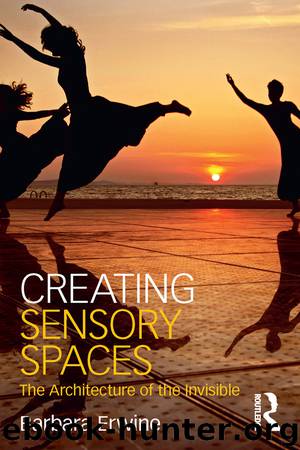Creating Sensory Spaces by Barbara Erwine

Author:Barbara Erwine
Language: eng
Format: epub
Publisher: Routledge
UPON REFLECTION
Our experience of aural architecture is strongly affected by the reflection of sound waves off physical objects in a space. The reflections can be either specular (reflecting at the same angle as they initially hit the surface, as a mirror reflects light) or diffuse (dispersing in different directions so that the sound loses its directionality and is scattered like light bouncing off a rough surface). Each material has different characteristics of reflection, transmission, and absorption, and the proportion for each varies depending on the wavelength of the sound. Peter Zumthor calls this to mind as he urges us to
“Listen! Interiors are like large instruments, collecting sound, amplifying it, transmitting it elsewhere. It has to do with the shape peculiar to each room and with the surfaces of the materials they contain and the way those materials have been applied.”15
We can think of all these sounds and reflections as the voice of the building carrying on a conversation with us and providing information about the surfaces around us.
If we run down a fight of oak stairs in hard-soled shoes, the sound of our foot’s impact on each step transmits out in all directions, and its intensity decreases the further it travels. Although some focused sounds project out in a specific direction, most sounds, like the footfall on the stair, are omnidirectional; that is, they radiate out from the sound source in concentric circles like ripples of water from a stone thrown into a pond. Upon encountering an object, such as an adjacent wall, the sound wave is absorbed, reflected and transmitted in proportions that depend on the object’s material characteristics. The first sound wave we detect is the sound on its shortest path direct from the source to our ears. This initial sound and the reflections that closely follow it give us information about the direction of the sound. This information was critically important in our evolutionary development because it let us know if a predator was stalking us from the left or right side. So even today we react to these early sounds, instinctively turning our head in response to them if they are loud or unexpected.
The parts of the wave that don’t travel directly to our ears hit surfaces and objects in the space around us, bounce off them and may eventually reach our ears through multiple reflections. Acoustic reflections can bounce around in a space for a long time so we first hear the direct sound and then, sometimes many seconds later, hear the reflections, each of which have taken a different path to our ears. The more reflective the materials in the space are, the more reflections are possible, creating a rich, full sound. This is called a “live” space and is the effect commonly enjoyed by those who sing in the shower, listen to Bach in a cathedral or delight in the sound of a water droplet in a dark cave.
Both early and later reflections carry information about the surfaces they’ve encountered on their journey toward our ears.
Download
This site does not store any files on its server. We only index and link to content provided by other sites. Please contact the content providers to delete copyright contents if any and email us, we'll remove relevant links or contents immediately.
| Automotive | Engineering |
| Transportation |
Whiskies Galore by Ian Buxton(41880)
Introduction to Aircraft Design (Cambridge Aerospace Series) by John P. Fielding(33064)
Small Unmanned Fixed-wing Aircraft Design by Andrew J. Keane Andras Sobester James P. Scanlan & András Sóbester & James P. Scanlan(32743)
Craft Beer for the Homebrewer by Michael Agnew(18140)
Turbulence by E. J. Noyes(7936)
The Complete Stick Figure Physics Tutorials by Allen Sarah(7307)
Kaplan MCAT General Chemistry Review by Kaplan(6867)
The Thirst by Nesbo Jo(6828)
Bad Blood by John Carreyrou(6552)
Modelling of Convective Heat and Mass Transfer in Rotating Flows by Igor V. Shevchuk(6391)
Learning SQL by Alan Beaulieu(6211)
Weapons of Math Destruction by Cathy O'Neil(6146)
Man-made Catastrophes and Risk Information Concealment by Dmitry Chernov & Didier Sornette(5921)
Digital Minimalism by Cal Newport;(5664)
Life 3.0: Being Human in the Age of Artificial Intelligence by Tegmark Max(5474)
iGen by Jean M. Twenge(5366)
Secrets of Antigravity Propulsion: Tesla, UFOs, and Classified Aerospace Technology by Ph.D. Paul A. Laviolette(5309)
Design of Trajectory Optimization Approach for Space Maneuver Vehicle Skip Entry Problems by Runqi Chai & Al Savvaris & Antonios Tsourdos & Senchun Chai(5011)
Pale Blue Dot by Carl Sagan(4912)
